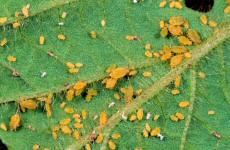|
The aphids were first discovered in
large numbers in soybean fields near the end of the 2000 growing
season. After careful scientific investigation, they were identified
as Aphis glycines, which had previously been reported only in Asia,
Australia and some Pacific islands.
Researchers from the National Soybean
Research Laboratory at the University of Illinois, however, have
recently discovered three soybean lines with strong resistance to
the aphids. These lines could eventually be incorporated into new
commercial varieties.
The lead scientists in the effort are
Glen Hartman, USDA plant pathologist at the U of I, and Curtis Hill,
senior research associate. Primary funding has been provided by the
Illinois Soybean Checkoff Board.
"Once the aphids infest a field, the
most common means of control is to spray the field with an
insecticide that can cost 20 to 25 dollars per acre or more,"
Hartman said. "If resistant commercial varieties were available, the
savings to growers could be substantial."
As part of a screening process,
researchers first evaluated the various commercial soybean varieties
that had been submitted to the yield trials at U of I for resistance
to the aphids. All of the initial screening work was done in an
isolated, air-conditioned greenhouse room on the U of I campus.
"After screening more than 700
varieties, we found that all of them were basically susceptible to
this pest," Hartman said. "We also determined that there had not
been any reported resistance from the germplasm screened in the part
of the world where the aphids originated, which is China. That was
surprising to us, and we wondered at that point if we would find any
resistance at all."
[to top of second column in
this article]

|

Soybean aphids
[Click on picture for larger image]
As the next step, they began screening
about 100 cultivars that had been identified as the major genetic
contributors to modern soybean varieties. Those ancestral lines
account for more than 90 percent of the genetic variation in our
current soybeans.
"If resistance exists, it seemed likely
that it would come from this group," Hill said. "Luckily we found
resistance in three different cultivars. One is called Jackson,
which is an old Southern cultivar. Another was Dowling, which also
is an old variety grown in the South. The third was a plant
introduction adapted to more northern conditions."
As part of the experimental design, the
three ancestral resistant cultivars were tested in a specially
designed field cage with several commercial varieties and were
treated with an insecticide or left untreated.
"Even with a large numbers of aphids
present, we found virtually no difference in yield and agronomic
traits whether these resistant lines were treated with an
insecticide or not," Hartman said. "At the same time, the commercial
varieties were severely damaged when they were not treated with an
insecticide, with many of the plants actually dying."
He emphasizes the resistance from these
lines remained effective throughout the extensive field tests
carried out over the last growing season.
"These are
the first reported sources of resistance in soybean to the aphid
found anywhere in the U.S.," Hartman said. "This marks a major first
step in dealing with the problems from this newly introduced soybean
pest. Work is already well under way to develop resistant germplasm
that will be made available to both public and private soybean
breeders interested in developing new resistant commercial
varieties."
[University
of Illinois news release]
|